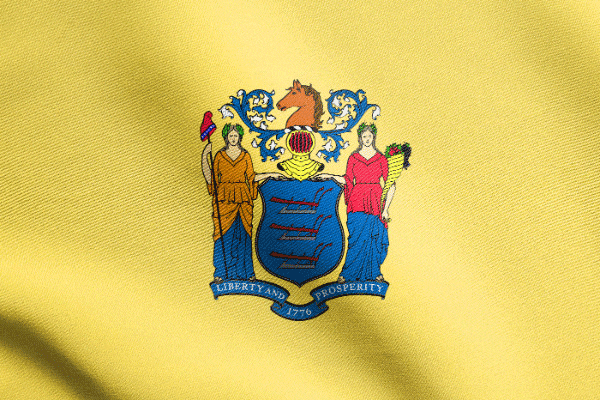New Jersey
State abbreviation/Postal code: N.J./NJ Governor: Chris Christie, R (to Jan. 2018) Senators: Robert Menendez, D (to Jan. 2019); Cory Booker, D (to Jan. 2021) Historical biographies of Congressional members Entered Union (rank): Dec. 18, 1787 (3) Present constitution adopted: 1947 Motto: Liberty and prosperity
Nickname: Garden State Origin of name: From the Channel Isle of Jersey 10 largest cities (2012 est.): Newark, 277,727; Jersey City, 254,441; Paterson, 145,219; Elizabeth , 126,458; Edison, 101,207; Toms River, 88,791; Clifton, 84,722; Trenton , 84,477; Camden, 77,250 Land area: 8,722.58 sq mi (22,591.38 km2) Geographic center: In Mercer Co., 5 mi. SE of Trenton Number of counties: 21 Largest county by population and area: Bergen, 905,116 (2010); Burlington, 805 sq mi. State forests: 11 State parks: 42 Residents: New Jerseyite, New Jerseyan 2016 resident population est.: 8,944,469 2010 resident census population (rank): 8,791,894 (11). Male: 4,279,600 (48.7%); Female: 4,512,294 (51.3%). White: 6,029,248 (68.6%); Black: 1,204,826 (13.7%); American Indian: 29,026 (0.3%); Asian: 725,726 (8.3%); Other race: 559,722 (6.4%); Two or more races: 240,303 (2.7%); Hispanic/Latino: 1,555,144 (17.7%). 2010 percent population 18 and over: 76.5; 65 and over: 13.5; median age: 39. |
New Jersey's early colonial history was involved with that of New York (New Netherlands), of which it was a part. One year after the Dutch surrender to England in 1664, New Jersey was organized as an English colony under Gov. Philip Carteret.
In 1676 the colony was divided between Carteret and a company of English Quakers who had obtained the rights belonging to John, Lord Berkeley. New Jersey became a united crown colony in 1702, administered by the royal governor of New York. Finally, in 1738, New Jersey was separated from New York under its own royal governor, Lewis Morris. Because of its key location between New York City and Philadelphia, New Jersey saw much fighting during the American Revolution.
Today, New Jersey, an area of wide industrial diversification, is known as the Crossroads of the East. Products from over 20,000 manufacturers can be delivered overnight to 100 million people. The greatest single industry is chemicals; New Jersey is one of the foremost research centers in the world. Many large oil refineries are located in northern New Jersey. Other important manufactured items are pharmaceuticals, instruments, machinery, electrical goods, and apparel.
Productive farmland covers about 790,000 acres, 16.7% of New Jersey's land area. The state ranks high in the production of almost all garden vegetables, as well as blueberries, cranberries, and peaches. Poultry, dairy products, and seafood are also top commodities.
Tourism is the second-largest industry in New Jersey. The state has numerous resort areas on 127 mi of Atlantic coastline. In 1977, New Jersey voters approved legislation allowing legalized casino gambling in Atlantic City. Points of interest include the Delaware Water Gap, the Edison National Historic Site in West Orange, Princeton University, Liberty State Park, Jersey City, and the N.J. State Aquarium in Camden.
The coast of New Jersey, Atlantic City to Hoboken, was battered by 2012's Hurricane Sandy in late October. About 2.4 million people lost power, 34 people were killed, and some 72,000 homes or businesses were damaged or destroyed. The storm caused nearly $38 billion in damage.
See more on New Jersey:
Encyclopedia: New Jersey
Encyclopedia: Geography
Encyclopedia: Economy
Encyclopedia: Government
Encyclopedia: History
Monthly Temperature Extremes
All U.S. States: Geography & Climate
Printable Outline Maps
Record Highest Temperatures
Record Lowest Temperatures
Highest, Lowest, and Mean Elevations
Land and Water Area
All U.S. States: Population & Economy
Historical Population Statistics, 1790–Present
Per Capita Personal Income
Minimum Wage Rates
State Taxes
Federal Government Expenditure
Percent of People in Poverty
Births and Birth Rates
Homeownership
Percentage of Uninsured by State
All U.S. States: Society & Culture:
Most Livable States
Healthiest States
Most Dangerous States
Smartest States
Crime Index
Residency Requirements for Voting
Compulsory School Attendance Laws
Driving Laws
National Public Radio Stations
Selected famous natives and residents:
- Bud Abbott comedian;
- Charles Addams cartoonist;
- Edwin Aldrin astronaut;
- Count Basie band leader;
- Joan Bennett actress;
- Jon Bon Jovi musician;
- Zach Braff actor, director;
- William J. Brennan jurist;
- Aaron Burr political leader;
- James Fenimore Cooper novelist;
- Lou Costello comedian;
- Stephen Crane writer;
- Helen Gahagan Douglas representative;
- Allen Ginsberg poet;
- William Frederick Halsey, Jr. admiral;
- Alfred Joyce Kilmer poet;
- Ernie Kovacs comedian;
- Jerry Lewis comedian and film director;
- Anne Morrow Lindbergh author;
- Norman Mailer novelist;
- Patricia McBride ballerina;
- Richard Nixon president;
- Dorothy Parker author;
- Paul Robeson singer and actor;
- Philip Roth novelist;
- Ruth St. Denis dancer and choreographer;
- Antonin Scalia jurist;
- H. Norman Schwarzkopf general;
- Frank Sinatra singer and actor;
- Bruce Springsteen musician;
- Alfred Stieglitz photographer;
- Albert Payson Terhune journalist and novelist;
- Sarah Vaughan singer;
- William Carlos Williams physician and poet;
- Bruce Willis actor;
- Edmund Wilson literary critic and author.


